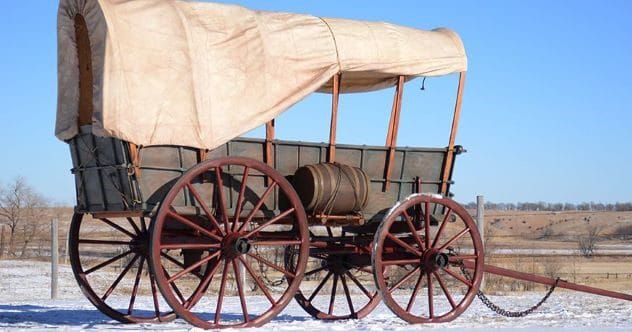We often picture the American frontier of the 1800s through a romantic lens. Images of brave explorers, happy families in snug log cabins, and a simple, fulfilling life free from modern stress fill our minds. Many even dream of being a pioneer, escaping today’s complexities for a freer existence.
However, this idealized vision of prairie life is far from the truth. Homesteading was an incredibly tough, lonely, and dangerous journey. Luxuries were scarce, and downsides were plentiful. The charming tales of Laura Ingalls Wilder’s Little House books and the nostalgic Oregon Trail game often smooth over the gritty, unpleasant details. It’s time to pull back the curtain on those misconceptions.
Here are ten reasons why life on the American frontier was, in reality, incredibly challenging.
10. Housing Was Inadequate
When settlers claimed land, they had five years to build a house. Most had very little money, and about half lost their claims before the five years were up. Affordability was key. In treeless areas, homes were often made of sod, not wood. These “soddies” were dark, constantly filled with bugs and vermin, and often leaked or caved in during rain.
Where trees were available, log cabins were common, but they weren’t the cozy retreats we imagine. Building them was exhausting. Men, often alone, chopped trees with only an ax and gathered tons of stone for foundations. Logs could weigh over 500 pounds! A typical cabin was a single room, perhaps 10 by 20 feet, with a sleeping loft. Ceilings were low, floors were dirt, and glass windows were a distant dream. Imagine a family of ten or more, all living, sleeping, and existing in that one small space. Privacy was non-existent.
9. Winters Were Brutal
Forget the image of a warm, toasty cabin in winter. In reality, cabin walls offered little insulation against the biting cold. It was often just as cold inside as it was outside. Fires helped a little, but much of the warm air escaped. Soddies were slightly better insulated, but leaky roofs were a constant problem with rain or snow.
Keeping the fire going was vital for survival, even if it didn’t provide much warmth. A family needed a woodpile as large as their cabin to last the winter. On the prairies, where wood was scarce, settlers burned dried buffalo dung, called “buffalo chips.” Despite their efforts, the fire was a small comfort against the harsh, miserable winters.
8. Horrible Deaths and Disease Were Common
Life on the frontier was filled with daily dangers. Accidents like being crushed by a wagon wheel, a misplaced ax swing, or an attack by a wild animal during a hunt were tragically common. Reloading a gun was a slow process, leaving hunters vulnerable.
The cramped living conditions meant diseases spread like wildfire. If one person got sick, the whole family usually followed. It wasn’t unusual for an illness to wipe out multiple children in a single family. On wagon trains, hundreds shared a single water source, leading to outbreaks of diseases like cholera and dysentery. Dysentery, far from a joke, caused severe diarrhea that could lead to death by dehydration in hours. Sadly, those who died on the trail were often buried in shallow graves, sometimes dug up by wolves, leaving families with no final resting place to visit.
7. You Would Likely Never See Family Again
When a pioneer family decided to move west, they often did so knowing they might never see their loved ones again. First-hand accounts, especially from women, are filled with sorrow about leaving family and friends behind. Tending the land was a daily, all-consuming job. Travel by wagon was so slow that visiting home for a “vacation” was impossible. Mail could be sent, but a reply might take six long months to arrive, making communication agonizingly slow.
6. Loneliness and Depression Were Incredibly Common
Pioneers rarely had chances to socialize outside their immediate family. Constant work left little free time for visiting neighbors. Plus, homes were far apart. The Homestead Act of 1862 granted married couples 320 acres, meaning neighbors could be a half-mile away or more. Occasional community events like quilting bees existed, but these vanished in winter when it was too cold to travel.
Women were especially isolated, as their work revolved around the home and filled every moment of their day. While mental health wasn’t understood then as it is now, many personal accounts suggest that depression was widespread among homesteaders.
5. Your Whole Day Was Chores
It’s no surprise pioneers felt down; their entire existence was an endless cycle of chores. Just getting enough food took up most of the day. Midwestern land was tough to cultivate and needed constant attention. Men spent their days hunting and farming. Women gathered plants, prepared and preserved food, and managed household tasks. Preserving food for winter was crucial: canning fruits took hours, and meat was salted, brined (requiring careful cleaning before eating), or smoked (needing a fire tended for weeks).
Other chores for women included sewing all clothing by hand (no sewing machines!), laundry with a tub and washboard, and animal care like milking cows and mucking barns. There were no breaks, no vacations, and little time for anything enjoyable. Each day was a grind, with the certainty that tomorrow would bring more of the same.
4. Starvation Was Frequent
Pioneers traded surplus crops for money to buy staples like flour, and occasional treats like coffee or white sugar, at the general store. Unfortunately, some store owners would cut costs by adding fillers like plaster or sawdust to their goods. For many, trips to town were rare, perhaps only twice a year. A crop shortage meant little to trade and a struggle to afford even basic necessities.
These shortages were often due to factors beyond their control. Droughts or massive swarms of locusts could wipe out crops. In 1874, an infamous swarm of an estimated 12 trillion locusts darkened the sky and devoured entire fields in hours. Homesteaders were left with nothing to eat or sell. No amount of hard work could prevent these disasters; they simply had to be endured.
3. Water Was Gross and Hard to Come By
Unless a settler was lucky enough to claim land near a river, getting water was a huge challenge. Many dug wells near their homes. However, if the well did find water, it was often contaminated by seepage from the outhouse and barn. This meant all water had to be boiled before use, a tedious task given the difficulty of maintaining fires. Rainwater was collected too, but often attracted mosquitoes and dirt.
Most families resorted to daily trips, sometimes long ones, to fetch fresh water, adding hours to their already packed chore list. Even with all this effort, water was scarce. Hygiene suffered; families might bathe only once a week in the same water, which was then reused for laundry. Plates were often licked clean instead of washed. Clean, readily available water, something we take for granted, was a luxury few pioneers enjoyed.
2. Dealing with Waste Was Disgusting
While eastern cities were developing sewers and wealthy families had indoor plumbing, frontier families relied on outhouses. Some didn’t even bother with a structure, using bushes or open holes. Owning animals meant dealing with manure, usually just piled up. Families also kept piles of buffalo chips near their homes for winter fuel.
In summer, this waste created a terrible smell and attracted swarms of flies and mosquitoes. Since few could afford window screens, these pests were a constant presence indoors. Flies could be so bad that a child might be assigned to swat them away from the table during meals. In winter, outhouse reality was even grimmer: feces would freeze to the seats and have to be chipped off with a shovel. It was a far cry from sanitary living.
1. The Land Wasn’t Exactly “Unclaimed”
A troubling part of the frontier myth is how it portrays Native Americans – often as a single, violent group or, alternately, by painting the West as an empty wilderness waiting to be taken. While pioneer life was incredibly hard, it was even harder for the Native Americans already living there. They were forcibly removed from their ancestral lands, often violently, to make way for settlers. (Contrary to many Western movies, violence by Natives against settlers was relatively rare.)
Treaties and promises made to tribes were consistently broken. They were pushed onto smaller and smaller reservations, and compensation was often withheld. The government even encouraged the slaughter of buffalo herds, hoping to destroy the Native tribes’ primary food source. It’s impossible to talk about frontier difficulties without acknowledging this painful reality and the immense suffering inflicted upon Native peoples.










